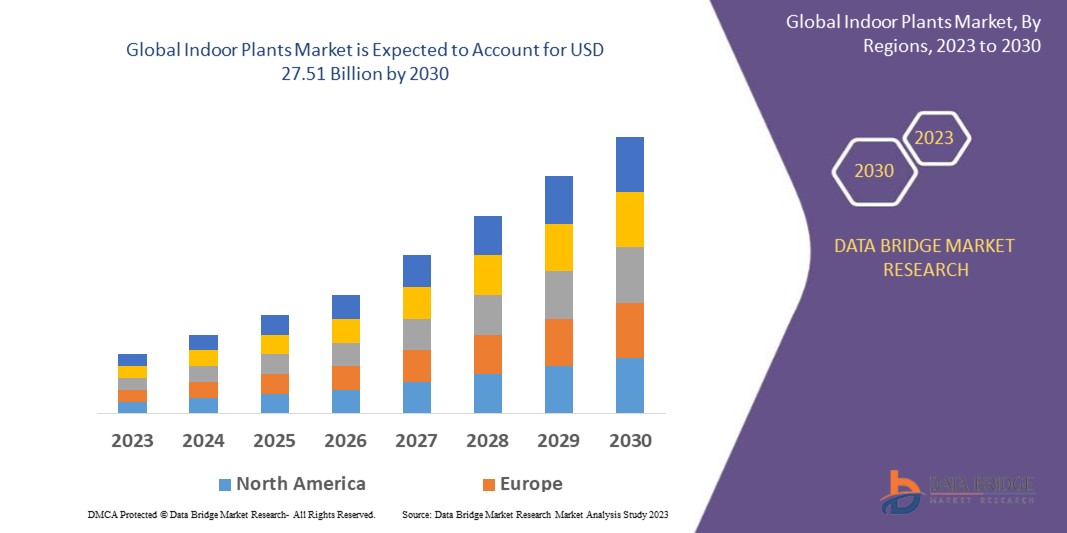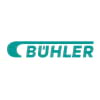Global Indoor Plants Market, By Type (Shade-loving plants, Low light plants and High light plants), Application (Absorb Harmful Gases and Home Decoration), Product (Succulent Plants, Berbaceous Plants, Woody Plants and Hydroponic Plants) – Industry Trends and Forecast to 2030.

Indoor Plants Market Analysis and Size
The indoor plants market is flourishing, propelled by a convergence of factors that resonate with a diverse consumer base. Aesthetic considerations and interior design trends heavily influence the demand for indoor plants, as they are increasingly seen as decorative elements that enhance the visual appeal of living spaces. Simultaneously, the growing awareness of wellness and health benefits associated with certain indoor plants, renowned for their air-purifying qualities, contributes significantly to their popularity.
Data Bridge Market Research analyses that the indoor plants market which was USD 18.80 billion in 2022, will reach USD 27.51 billion by 2030, and is expected to undergo a CAGR of 4.87% during the forecast period. “ shade-loving plants” dominates the types segment of the indoor plants market due to their adaptability to environments with limited natural sunlight. Ideal for spaces with small windows or shaded areas, these plants, including ferns, snake plants, and pothos, bring lush greenery and aesthetic appeal to indoor settings. In addition to the market insights such as market value, growth rate, market segments, geographical coverage, market players, and market scenario, the market report curated by the Data Bridge Market Research team includes in-depth expert analysis, import/export analysis, pricing analysis, production consumption analysis, and consumer behaviour.
Indoor Plants Market Scope and Segmentation
|
Report Metric |
Details |
|
Forecast Period |
2023 to 2030 |
|
Base Year |
2022 |
|
Historic Years |
2021 (Customizable to 2015-2020) |
|
Quantitative Units |
Revenue in USD Billion, Volumes in Units, Pricing in USD |
|
Segments Covered |
Type (Shade-loving plants, Low light plants and High light plants), Application (Absorb Harmful Gases and Home Decoration), Product (Succulent Plants, Berbaceous Plants, Woody Plants and Hydroponic Plants) |
|
Countries Covered |
U.S., Canada, Mexico, Brazil, Argentina, Rest of South America, Germany, France, Italy, U.K., Belgium, Spain, Russia, Turkey, Netherlands, Switzerland, Rest of Europe, Japan, China, India, South Korea, Australia, Singapore, Malaysia, Thailand, Indonesia, Philippines, Rest of Asia-Pacific, U.A.E., Saudi Arabia, Egypt, South Africa, Israel, Rest of Middle East and Africa |
|
Market Players Covered |
DÜMMEN ORANGE (U.S.), Syngenta (Switzerland), Beekenkamp Group (Netherlands), Hofland flowering plants (Netherlands), SAKATA (U.S.), DUTCH FLOWER GROUP (Netherlands), MARGINPAR BV (Netherlands), Walter Blom Plants BV (Netherlands), Selecta Klemm, Double H Nurseries Ltd, (Germany), ARCANGELI GIOVANNI (Italy), KP Holland (Netherlands), Ball Horticultural Company (U.S.), among others |
|
Market Opportunities |
|
Market Definition
It is clear from the name that indoor plants are plants that are grown indoors. Indoor plants can be grown in homes, offices, or any other indoor location. Growing indoor plants is thought to bring a lot of positivity and benefits. Indoor plants increase the oxygen level, purify the air in the home, remove pollutants, and reduce the rate of indoor air pollution.
Global Indoor Plants Market Dynamics
Drivers
- Health Benefits Associated with Indoor Gardening
Indoor plants are thought to reduce stress and to be therapeutic. People suffering from mental illnesses are often advised to begin indoor gardening as horticultural therapy to improve feelings of well-being in people suffering from depression, anxiety, dementia, and other conditions. It aids in relaxation, concentration, and connecting with nature and one another. The global indoor plants market is being driven by rising demand for indoor plants and flowers in the residential sector.
- Increasing Popularity of Indoor Plants as Interior Decoration
The indoor plants various colours, which include white, pink, and violet, make it popular for home decoration. The growing popularity of the indoor plants as a decorative element is expected to drive market growth. The increasing popularity of indoor plants as interior decoration is a notable trend in the realm of indoor plants. Beyond their traditional role as air purifiers, plants are now embraced for their aesthetic value, transforming living spaces into green sanctuaries. Interior design trends have shifted towards incorporating a variety of plants, ranging from succulents to large leafy specimens, to add texture, color, and life to indoor environments.
Opportunities
- Growing Wellness Trend
The increasing focus on health and wellness presents a significant opportunity for the indoor plants market. Consumers are recognizing the air-purifying benefits and stress-reducing properties of indoor plants, leading to a higher demand for greenery in homes and workplaces. Indoor plants are known for their ability to purify the air by absorbing pollutants and releasing oxygen. This is especially appealing in urban environments where air quality can be a concern.
- E-Commerce Growth
The expansion of e-commerce platforms provides an opportunity for the indoor plants market to reach a broader audience. Online platforms facilitate easy access to a variety of indoor plants, supporting the convenience and preferences of consumers. E-commerce provides a convenient platform for consumers to browse and purchase indoor plants without leaving their homes. This is especially appealing to individuals with busy schedules who may not have the time to visit physical stores.
Restraints/Challenges
- Seasonal Variability
The seasonal nature of the indoor plants market can pose challenges. Demand may fluctuate based on factors such as holidays, changing weather conditions, or seasonal preferences, requiring strategic planning and inventory management. Days are shorter in winter, and natural light may be limited. Consider placing plants near windows to maximize sunlight exposure. If natural light is insufficient, supplement
- Supply Chain Issues
The sourcing and transportation of live plants can be challenging, with factors such as weather, logistics, and plant health considerations affecting the supply chain. Ensuring the availability of healthy plants for consumers may pose logistical challenges. Adhering to manufacturer guidelines and working with experienced HVAC professionals can provide valuable insights and ensure proper maintenance practices are followed. Also, the lack of favorable reimbursement scenarios and technology penetration in the developing economies, heavy custom duty imposed on medical devices, and lack of suitable infrastructure in low and middle-income countries are projected to challenge the market in the forecast period of 2023 to 2030.
This indoor plants market report provides details of new recent developments, trade regulations, import-export analysis, production analysis, value chain optimization, market share, the impact of domestic and localized market players, analyses opportunities in terms of emerging revenue pockets, changes in market regulations, strategic market growth analysis, market size, category market growths, application niches and dominance, product approvals, product launches, geographic expansions, technological innovations in the market. To gain more info on the indoor plants market contact Data Bridge Market Research for an Analyst Brief, our team will help you make an informed market decision to achieve market growth.
Recent Developments
- In January 2022, Bloomscape revolutionized the market with the release of its bloomscape app, which provided users with a seamless plant purchasing and care experience
- In March 2021, The plant exchange debuted its innovative plant exchange app, allowing indoor plant enthusiasts to trade and sell their cherished plants with simplicity
Global Indoor Plants Market Scope
The indoor plants market is segmented on the basis of type, application, product. The growth amongst these segments will help you analyze meagre growth segments in the industries and provide the users with a valuable market overview and market insights to help them make strategic decisions for identifying core market applications.
Type
- Shade- loving plants
- Low light plants
- High light plants
Application
- Absorb Harmful Gases
- Home Decoration
Product
- Succulent Plants
- Berbaceous Plants
- Woody Plants
- Hydroponic Plants
Global Indoor Plants Market Regional Analysis/Insights
The global Indoor plants market is analysed and market size insights and trends are provided by type, application, product as referenced above.
The countries covered in the Indoor plants market report are U.S., Canada, Mexico, Brazil, Argentina, Rest of South America, Germany, France, Italy, U.K., Belgium, Spain, Russia, Turkey, Netherlands, Switzerland, Rest of Europe, Japan, China, India, South Korea, Australia, Singapore, Malaysia, Thailand, Indonesia, Philippines, Rest of Asia-Pacific, U.A.E., Saudi Arabia, Egypt, South Africa, Israel, Rest of Middle East and Africa
Europe dominates the indoor plants market as this region is the world's largest producer and exporter of indoor plants in this region.
North America is expected to witness significant growth during the forecast period of 2023 to 2030 as consumer awareness grows in this region.
The country section of the report also provides individual market impacting factors and changes in regulation in the market domestically that impact the current and future trends of the market. Data points such as down-stream and up-stream value chain analysis, technical trends, and porter's five forces analysis, case studies are some of the pointers used to forecast the market scenario for individual countries. Also, the presence and availability of global brands and their challenges faced due to large or scarce competition from local and domestic brands, the impact of domestic tariffs, and trade routes are considered while providing forecast analysis of the country data.
Competitive Landscape and Indoor Plants Market Share Analysis
The indoor plants market competitive landscape provides details by competitors. Details included are company overview, company financials, revenue generated, market potential, investment in research and development, new market initiatives, global presence, production sites and facilities, production capacities, company strengths and weaknesses, product launch, product width, and breadth, application dominance. The above data points provided are only related to the company's focus related to the indoor plants market.
Some of the major players operating in the indoor plants market are:
- DÜMMEN ORANGE (U.S.)
- Syngenta (Switzerland)
- Beekenkamp Group (Netherlands)
- Hofland flowering plants (Netherlands)
- SAKATA (U.S.)
- DUTCH FLOWER GROUP (Netherlands)
- MARGINPAR BV (Netherlands)
- Walter Blom Plants BV (Netherlands)
- Selecta Klemm, Double H Nurseries Ltd, (Germany)
- ARCANGELI GIOVANNI (Italy)
- KP Holland (Netherlands)
- Ball Horticultural Company (U.S.)
SKU-





 Forecast Period
Forecast Period  Market Size (Base Year)
Market Size (Base Year)  Market Size (Forecast Year)
Market Size (Forecast Year) CAGR
CAGR










